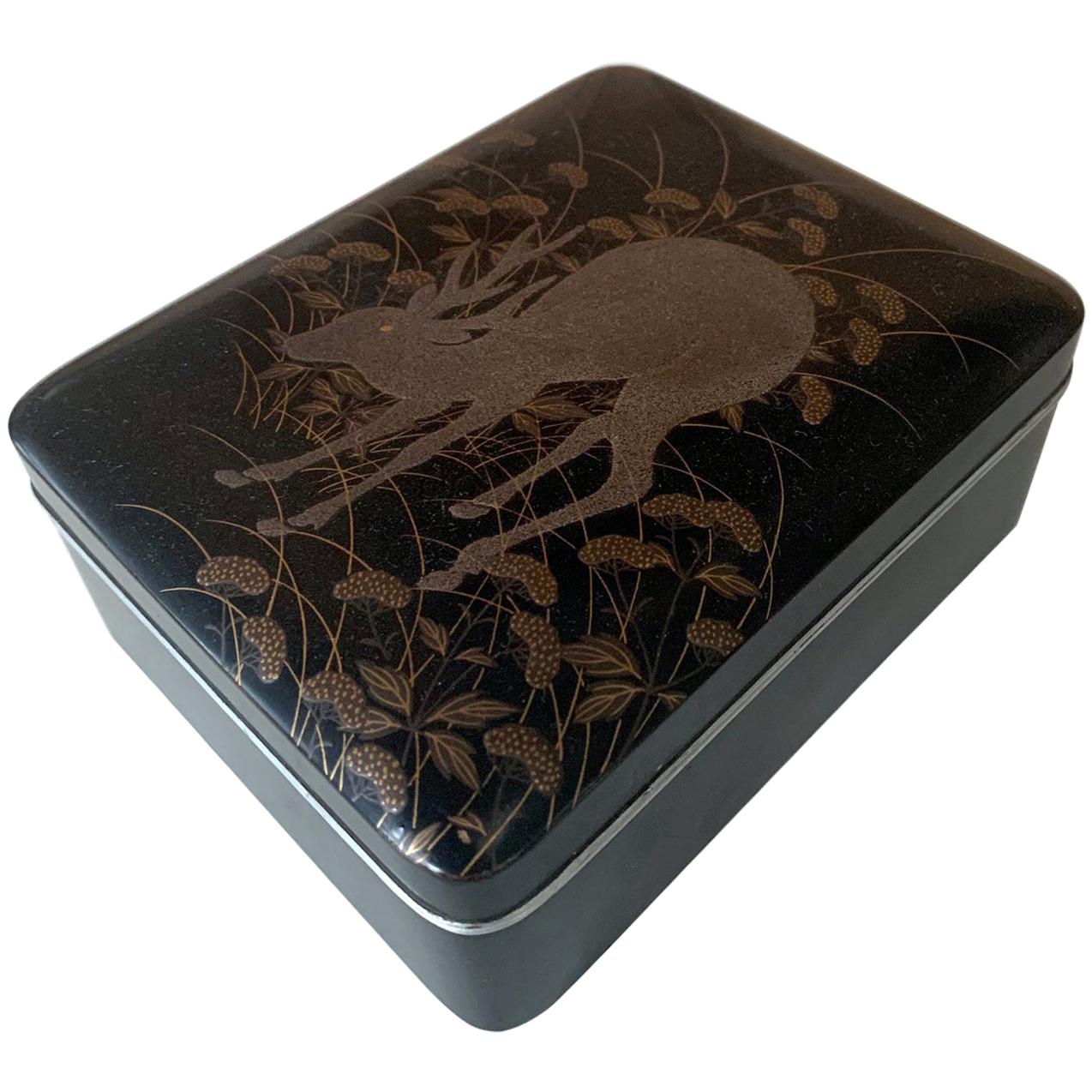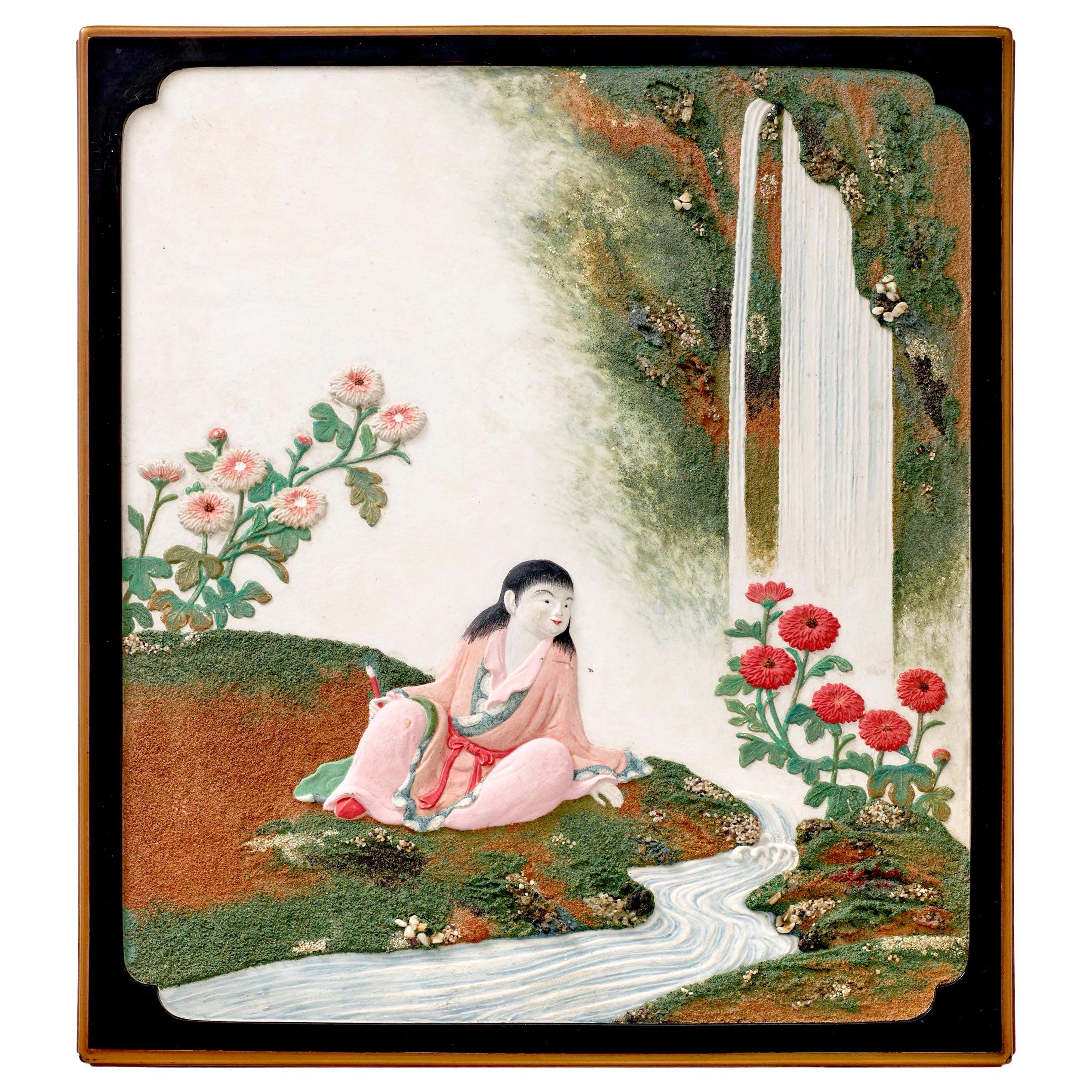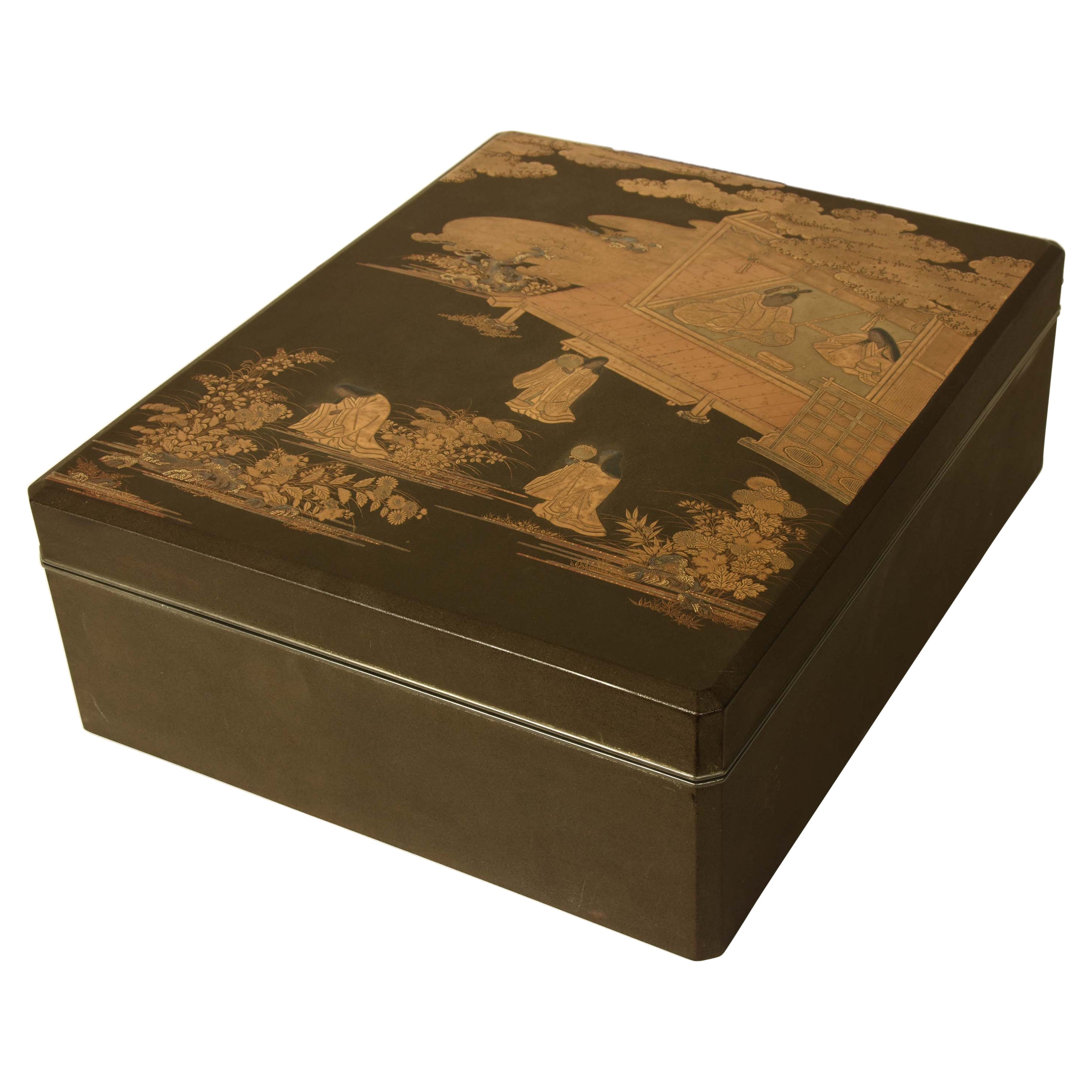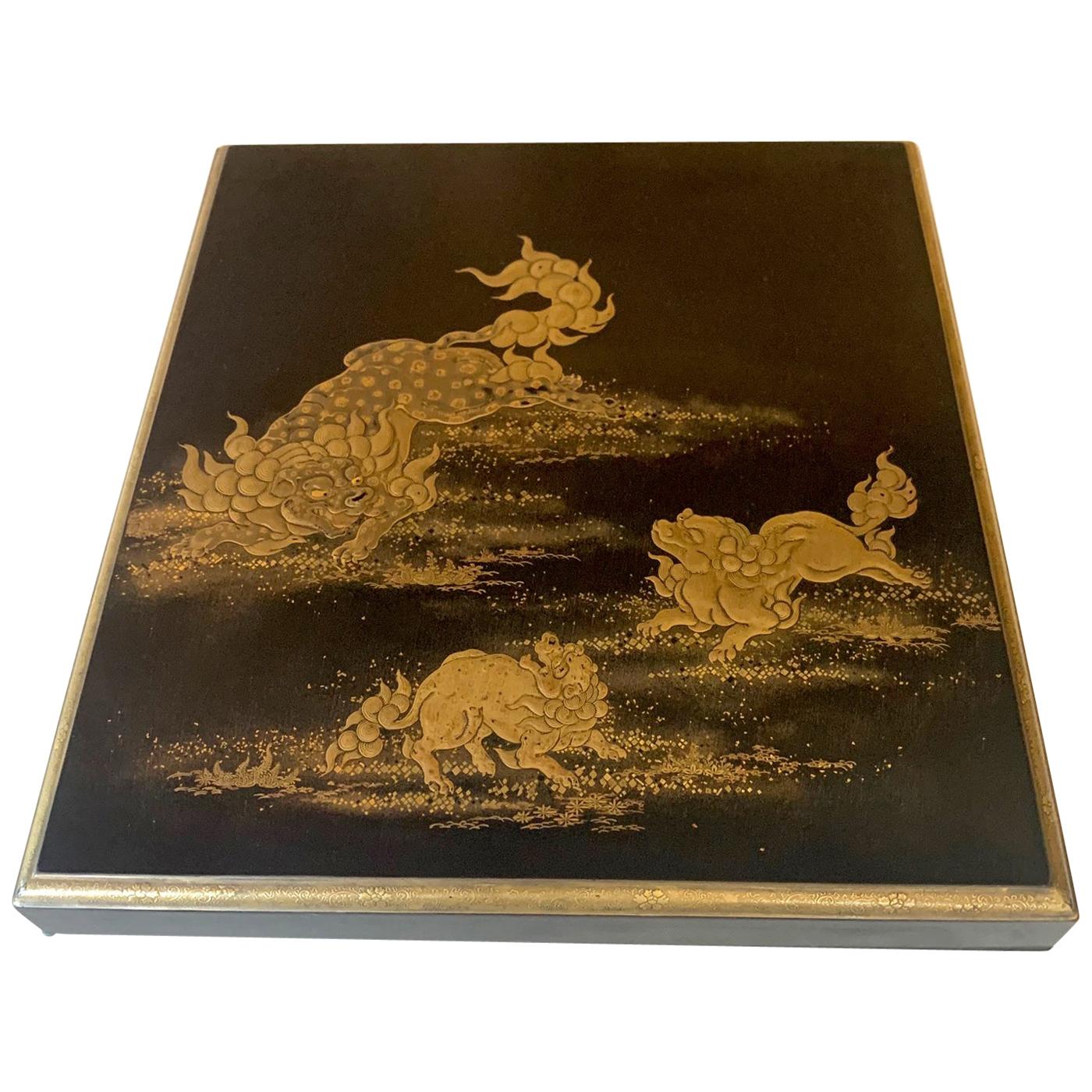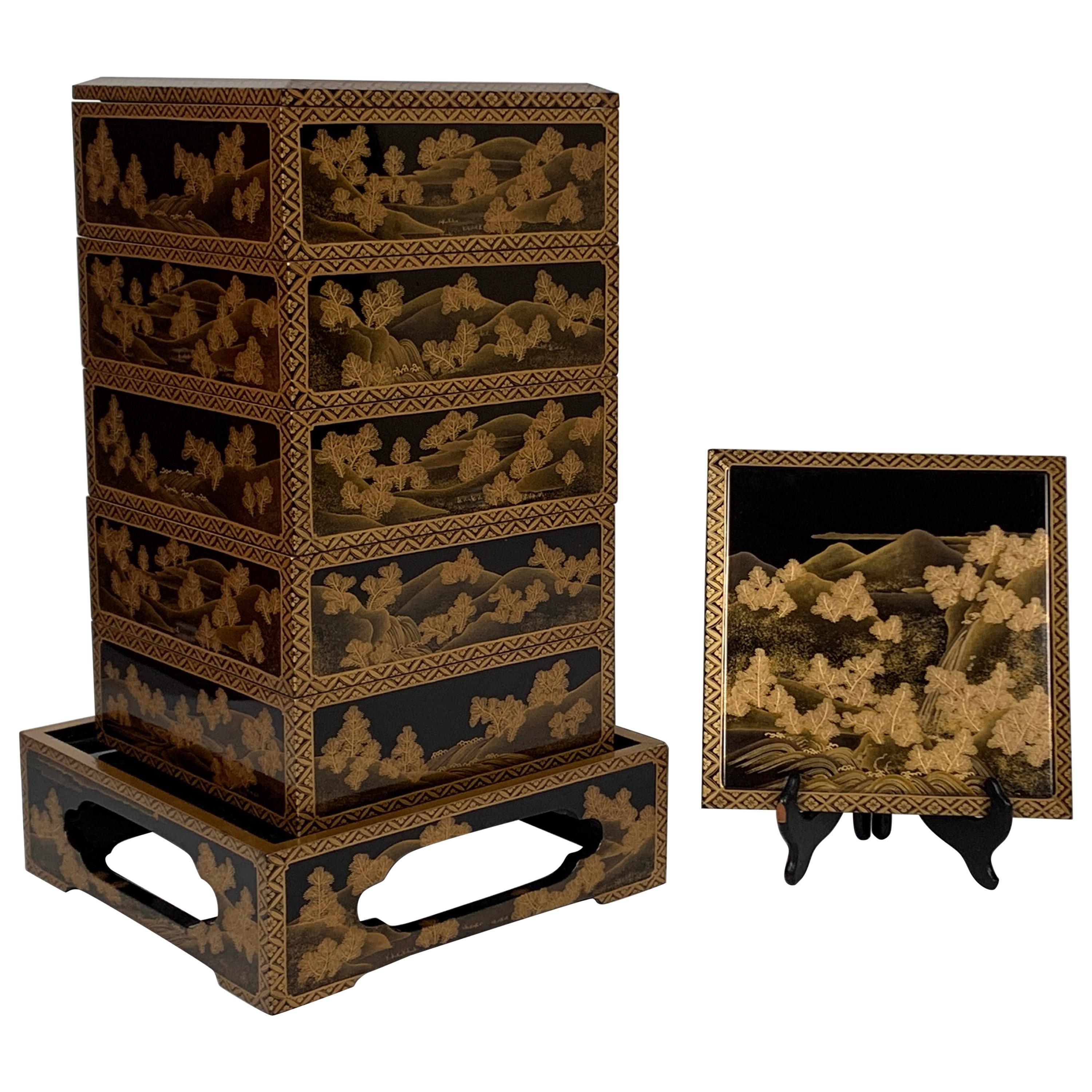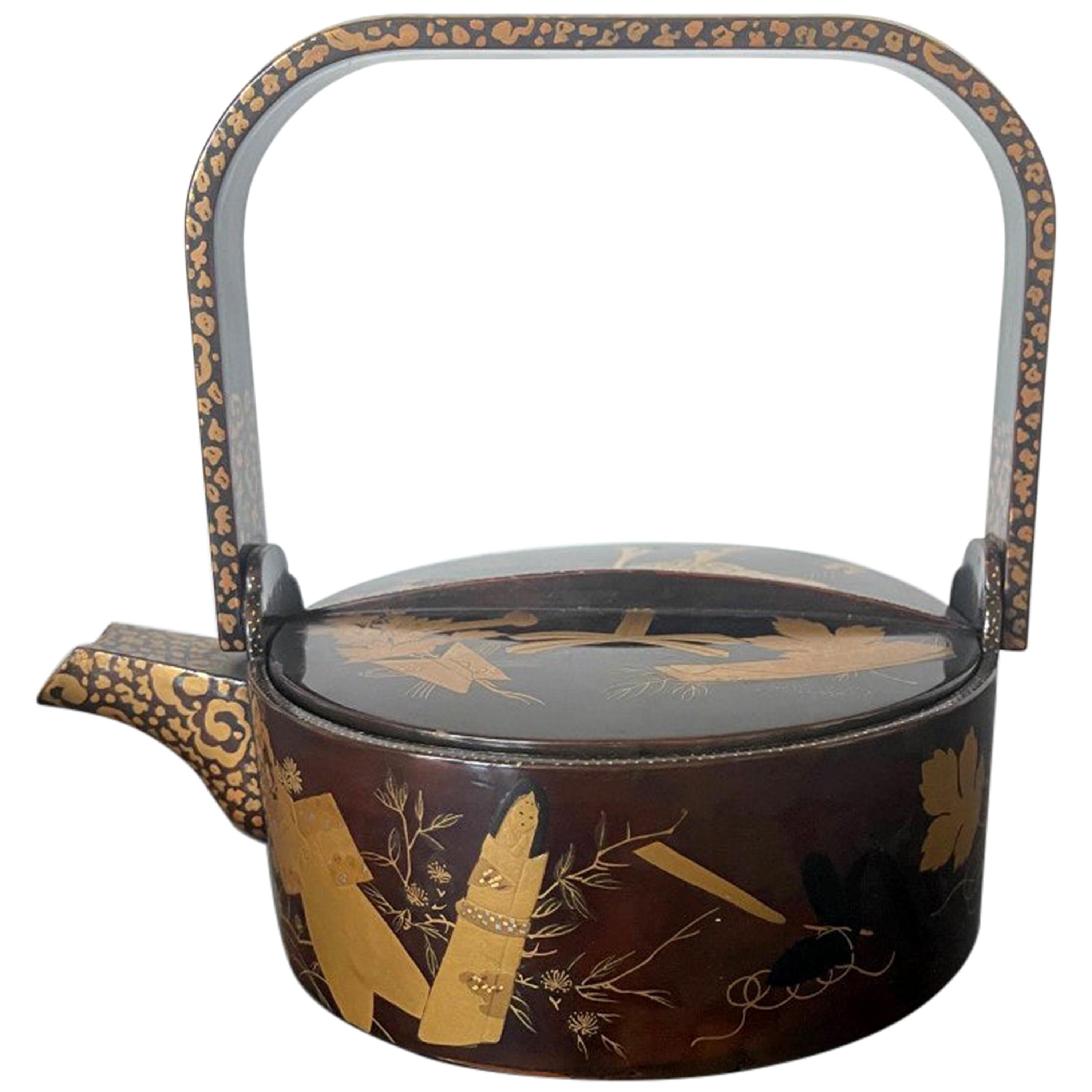Items Similar to Japanese Lacquer Ryoshibako Document Box Meiji Period
Want more images or videos?
Request additional images or videos from the seller
1 of 21
Japanese Lacquer Ryoshibako Document Box Meiji Period
About the Item
A large Japanese lacquer box with elaborate Maki-e design from Meiji period, (mid-late 19th century). The generous size of the box was reserved for paper document and called Ryoshibako in Japanese. The cover of the lid is decorated with a tour-de-force range of techniques: including low and high relief Maki-e (known as Hiramaki-e and takamaki-e respectively) and gold leaf fundame. Masterfully, the artisan used these approaches to depict a gorgeous flower cart with flowing ribbons. The cart carries a large basket with the most exuberant floral arrangement, showcasing peonies, chrysanthemums, branches of plum blossom, hibiscus, and Japanese irises. The interior of the lid was given an equal if not more poetic rendition, this time, of a Classic Japanese scenery. A flowing river is anchored by rock outcrops and pine trees frame the view point. Flocks of crane fly in the sky and two turtles sun themselves by the bank. The side of the box was all decorated with elaborate floral arrangement. The background Nashiji surface has a reddish glow to mimic the pear skin, with the outside mellowed into a beautiful patina of a pleasing brown hue, compared to the much shinier interior.
This Ryoshibako is, with no doubt, was crafted by a master. From the overall composition, to the attention to details on the smallest scale are just astounding. The stunning condition suggests that it was cherished with utmost care.
- Dimensions:Height: 6.5 in (16.51 cm)Width: 13 in (33.02 cm)Depth: 16.75 in (42.55 cm)
- Style:Japonisme (Of the Period)
- Materials and Techniques:
- Place of Origin:
- Period:
- Date of Manufacture:19th Century
- Condition:Repaired: A couple of small restoration on the fundame gold foil, including a small area on a spoke of the wheel, also on the petal of a flower on the side of the box. See detail images as the repair area has a slightly more shining gold color. Wear consistent with age and use. Minor losses. Fine condition overall, with minor contact wear on the corner and small scratches on the base. Mellowed natural patina on the exterior surface.
- Seller Location:Atlanta, GA
- Reference Number:1stDibs: LU945020575512
About the Seller
5.0
Platinum Seller
These expertly vetted sellers are 1stDibs' most experienced sellers and are rated highest by our customers.
Established in 2006
1stDibs seller since 2010
479 sales on 1stDibs
Typical response time: <1 hour
- ShippingRetrieving quote...Ships From: Atlanta, GA
- Return PolicyA return for this item may be initiated within 2 days of delivery.
More From This SellerView All
- Japanese Rinpa Style Lacquer Box Meiji PeriodLocated in Atlanta, GAA black lacquer tebako (hand box) with maki-e decoration and silver trim, circa late 19th century, Meiji period. The surface of the lid features a Rinpa style maki-e paint depicting ...Category
Antique 1890s Japanese Japonisme Lacquer
MaterialsWood, Lacquer
- Rare Japanese Lacquer Writing Box Suzuribako Meiji PeriodLocated in Atlanta, GAA Japanese Lacquer writing box Suzuribako Meiji Period (1868-1912), likely circa late 19th century. This suzuribako is one of the most unusual boxe...Category
Antique 19th Century Japanese Japonisme Lacquer
MaterialsLacquer
- Japanese Lacquer Box with Fine Maki-e Decoration Meiji PeriodLocated in Atlanta, GAA lacquered wood box with lid from Japan circa 19th century Meiji Period. The finely decorated box was used to store paper slips and small documents on the desk. It is overall finished with black lacquer (kuro) with sparse Mura-Nashiji effect outside and on the top surface of the lid, there are three Komainu, (sometimes known as Shishi or Japanese lions) frolicking and forming a circle in lively motion. Komainu are auspicious animals in Japanese cultures in both Shinto and Buddhism tradition. Originally from China, these animals symbolizes guardians to ward off evil spirits. Hiramaki-e was used in combination with carving and combing to render the lions with various surface textures. A gilt border with an slight angle was given to the lid and even the thin band is decorated with miniature floral scrolls. The interior of the box was finished in a dense nashiji. Underneath the lid, a cluster of peonies open lavishly by two gentle mounts. Takamaki-e (high relief) in both gold and silver were...Category
Antique Late 19th Century Japanese Japonisme Lacquer
MaterialsWood, Lacquer
- Japanese Lacquer Maki-e Sake Ewer Meiji PeriodLocated in Atlanta, GAA Japanese lacquered wood sake ewer with maki-e design, circa late 19th century, Meiji period. The nicely decorated lacquerware is of a Classic sake ewer for...Category
Antique 1890s Japanese Japonisme Lacquer
MaterialsLacquer
- Japanese Lacquer Maki-E Tiered Suzuribako and RyoshibakoLocated in Atlanta, GAA Japanese roiro lacquer scholar combo box with an upper tier of inkstone box (Suzuribako) and a lower document box (Ryoshibako) circa 1910-30s (end of Meiji to Showa period). The high glossy box was beautifully decorated with an image of the famously eccentric Buddhist monks Hanshan and Shide (known in Japan as Kanzan and Jittoku). Often as a pair, they have been a popular motif in Japanese Zen painting...Category
Vintage 1920s Japanese Meiji Lacquer
MaterialsStone, Metal
- Large Japanese Lacquer Box Early Edo Period Ex-Christie'sLocated in Atlanta, GAA large lacquer Ryoshibako (Paper box in Japanese) finely decorated with Maki-e circa 17th century early Edo period. The box is of an impressive size and was used to store paper documents. Both sides of the lid were elaborately decorated with maki-e and the edge was befitted with lead rim, an early practice before the silver rim became common later. The interior and base were finished in Nashiji. The night scene on top surface of the lid depicts flocks of chidoris flying in formation from a sea shore swaying with reeds under a full moon, using hiramaki-e in both gold and silver. Ribbons of clouds were achieved with different densities of gold powder. The underside, in contrast, shows a crescent moon in takamakie-e above the sea with ferns and reeds. Chidoris, the plovers, are symbolic in Japanese culture as "thousands of blessings" and longevity. The Namichidori, the pattern in which the chidori flies in the nami (wave) represents the eternal love and safety of couples and families. For detailed references on the historical background and the use of chidoris on lacquerware, see the reference below. This very lacquer box was featured for sale as lot 339 in Christie's London Sale Japanese Art...Category
Antique 17th Century Japanese Japonisme Lacquer
MaterialsWood, Lacquer
You May Also Like
- Japanese Black Lacquer Document Box with Gold Maki e Design, Meiji PeriodLocated in Prahran, VictoriaAn antique black lacquer document box with an exquisitely detailed, finely wrought design from The Tale of the Genji depicted in gold maki e across the lid. Internally, the box is de...Category
Early 20th Century Japanese Lacquer
MaterialsWood, Lacquer
- Japanese Maki-e Lacquer Stacking Box, Jubako, Meiji Period, JapanLocated in Austin, TXA fine and impressive Japanese gold maki-e decorated black lacquer five-tier jubako with presentation tray, two lids, and the original tomobako storage box, Meiji period, late 19th c...Category
Antique Late 19th Century Japanese Meiji Lacquer
MaterialsLacquer
- Japanese Lacquer House Shaped Incense Box, Kogo, Meiji Period, JapanLocated in Austin, TXA delightful and intricately decorated lacquer box for storing incense, kogo, in the form of a traditional farm house, Meiji period (1864 - 1912), late 19th century, Japan. The kogo, or small box for storing incense, takes the whimsical form of a traditional Japanese home, minka, with the removable high, thatched roof serving as the cover for the box. The exterior of the home has been painstakingly decorated in maki-e lacquer against a matte black lacquer ground. Traditional shoji doors, bamboo blinds...Category
Antique Late 19th Century Japanese Meiji Lacquer
MaterialsLacquer
- Japanese 7-Pcs, Arita Sweetmeat Set & Matching Lacquer Box Meiji Period, 1880sLocated in Ottawa, OntarioA seven-piece Japanese Arita Sweetmeat set and matching lacquer box, Meiji period (1880-1890). Comprising of a central hexagonal dish and six-fan shaped ...Category
Antique Late 19th Century Japanese Meiji Lacquer
MaterialsPorcelain, Lacquer
- Japanese Meiji Period Antique Lacquer Box with Gold Maki-e DecorationLocated in New York, NYA fine antique Japanese Meji Period lacquer box decorated with a fan and a stylized star shaped window in the maki-e technique. The fan at the top right corner, fully opened depictin...Category
Antique 19th Century Japanese Meiji Lacquer
MaterialsLacquer
- Japanese Black Lacquer Document Box with Plum Blossom Design, Taisho PeriodLocated in Prahran, VictoriaA high quality, antique, Japanese black lacquer document box. It has an external design of gold maki e plum blossoms. In Japanese culture plum blossom symbolises the beginning of Spring, having its own festival, the Ume Matsuri, alongside the more famous cherry blossom festival...Category
Vintage 1920s Japanese Lacquer
MaterialsWood, Lacquer
Recently Viewed
View AllMore Ways To Browse
Brown Lacquer
Lacquer Brown
Mid Century Lacquer
Mid Century Lacquered
Lacquered Midcentury
Lacquer On Wood
Mid Century Wood And Lacquer
Patina Lacquer Furniture
Antique Document
Antique Documents
Japanese Interior Furniture
Lacquer Box
Lacquered Box
Wood Lacquered Box
Antique Lacquer Box
Antique Lacquer Boxes
Japanese Low Furniture
Low Japanese
